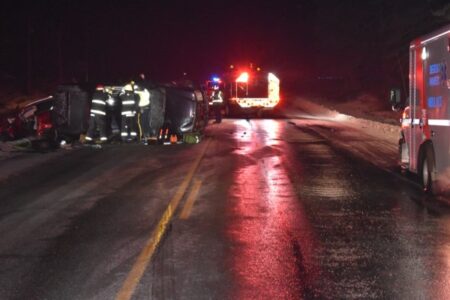US-Canada Regulatory Cooperation Council plans Orwellian transportation pact
EDITOR’S NOTE: This is the second of three articles by Nelle Maxey examining the wide-ranging ramifications for the Canadian public, economy and environment of the new Canada-US Border Security Deal and its ancillary agreements.
With my first article on this topic I set the background for Canada’s new trade deal with the US and discussed the Regulatory Cooperation Council (RCC) and its Joint Action Plan for cooperation in the Energy & Environment trade sector. This installment will look at the Transportation sector as discussed in the RCC Action Plan and the poison pills therein. Remember, “a spoonful of sugar makes the medicine go down”.
The Joint Action Plan divides transportation into three modes of travel: land (vehicle and rail), marine travel and air travel. To facilitate cross-border trade, the land section will align both vehicle and rail safety regulations, the marine section will align recreational boat building and life jacket standards and the final section will align transport of dangerous goods regulations. So that’s the sugar. The medicine is as follows.
On page 18 of the RCC Plan this clause is found in the land travel initiatives: “Work together on the development of regulations and standards to fully support the integration of intelligent transportation systems.”
The benefits of this initiative are listed on the same page as follows: “Coordinated standards for intelligent transportation systems will promote the seamless development of tomorrow’s vehicle technologies and infrastructure and allow the two countries to be global leaders in this area.”
Turning to wikipedia for a definition of “intelligent transportation systems”, you find the following:
The term intelligent transportation systems (ITS) refers to information and communication technology (applied to transport infrastructure and vehicles) that improve transport outcomes[1] such as transport safety, transport productivity, travel reliability, informed travel choices, social equity, environmental performance and network operation resilience.
That sounds laudable enough – until you read the next section titled Background:
Recent governmental activity in the area of ITS – specifically in the United States – is further motivated by an increasing focus on homeland security. Many of the proposed ITS systems also involve surveillance of the roadways, which is a priority of homeland security.[2] Funding of many systems comes either directly through homeland security organizations or with their approval…Much of the infrastructure and planning involved with ITS parallels the need for homeland security systems.
Since it is the US with whom we are “harmonizing”, a bit different spin on ITS emerges. Reading further in the wiki article you can find out about RFID chips, CTV cameras, “floating” vehicle GPS data and “floating” cell phone data and how these data sources are tapped into by these “intelligent” systems. I can only suggest that a better name for these systems might be intelligence systems. Is this really how you want your tax dollars spent? All under the guise of traffic control and traffic safety?
Unfortunately, it gets worse. The RCC Plan’s marine travel section reads:
Align the marine transportation security requirements to prevent duplication of services and remove impediments to cross-border operations and incorporate the ability to use alternative security arrangements in the Canadian regulations.
So cross-border security operations will have no impediments? I can only suppose this means we will see more presence of American enforcers in Canadian waters. The phrase “alternative security arrangements” is undefined in the document; so this remains food for thought and investigation. Although the following section may provide more clues as to where things are headed.
The air travel section is much more explicit. Here is the initiative from page 20 of the RCC Joint Action Plan:
Establish a mechanism to share experiences on regulations related to unmanned aircraft systems, with a view to aligning regulatory approaches. (emphasis added)
The benefits of this initiative are stated on the same page as follows:
Aligning Canadian and U.S. requirements for unmanned aircraft systems would allow both countries to gain safe and routine access to airspace without restricting other airspace users.
So, apparently opening up Canadian airspace to drones is now a priority and we must draft regulations for this. Or perhaps as this American news broadcast explains, we will just be adopting the US FAA regulations which are now being drafted “to allow unarmed drones to fly up to 400 feet above the ground”?
The discussion on page 19 in the Joint Action Plan says:
…for unmanned aircraft systems—aircraft weighing less than 35 kg [77lbs] used for flight testing, aerial photography, filming for television documentaries, or offshore geophysical surveys. Canada and the U.S. can jointly undertake to develop and adopt common standards for unmanned aircraft systems and establish a mechanism to share regulatory experiences, with a view to aligning regulatory approaches.
Oh, well, you think – this is just about little drones used for benign aerial photography. Watch this January, 2010, news video out of Houston,Texas to see the 40-pound drone being tested for us by local police and to hear the police chief’s comments on its possible uses.
More recently, on December 11th, an article was posted by the LA Times on police use of drones in North Dakota which belonged to US Customs and Border Protection to chase down rustlers of 6 cows. This article was followed two days later by an article in the Wall Street Journal titled, “The Law’s New Eye in the Sky: Police Departments’ Use of Drones Is Raising Concerns Over Privacy and Safety”.
The article begins:
Drones, the remote-controlled aircraft used in combat zones, are now hovering over some U.S. cities as police enlist them to get a bird’s-eye view of crime scenes and accidents at relatively low expense.
But as financially strapped municipalities add drones to their crime-fighting arsenal, they are facing increasing questions about the vehicles’ safety, as well as their potential to violate citizens’ privacy.
The story was accompanied by the photograph shown at the top of this article.
Considering that the Border Security deal not only appears to allow American agency operations on Canadian soil and does allow the transfer of data from said agencies, I can only ask: Is this what you want to see in Canada? Best contact your MP about these proposals.
Nelle Maxey is a grandmother who lives in the beautiful Slocan Valley in south-eastern BC. She believes it is her obligation as a citizen to concern herself with the policies and politics of government at the federal, provincial and local level. This article originally appeared in the Common Sense Canadian.























Comments